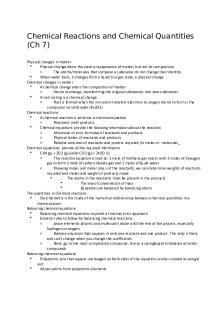Expt 4 chemical equilibium PDF

| Title | Expt 4 chemical equilibium |
|---|---|
| Author | Vivian Cao |
| Course | Introductory Chemistry |
| Institution | University of the Fraser Valley |
| Pages | 6 |
| File Size | 244.6 KB |
| File Type | |
| Total Downloads | 69 |
| Total Views | 156 |
Summary
lab report...
Description
CHEMISTRY 110
NAME
EXPERIMENT 4
SECTION
CHEMICAL EQUILIBRIUM: EQUILIBRIUM INVESTIGATIONS
DATE
AND LE CHÂTELIER’S PRINCIPLE
INSTRUCTOR
OBJECTIVES: This experiment will examine such shifts in equilibrium when changes in concentration or temperature of the system (Le Châtelier’s Principle).
DATA & OBSERVATIONS: Part A
Equilibrium Involving Thymol Blue Thymol blue (blue form) + H +
H- Thymol blue+ (yellow form)
Write the equations for the equilibrium system
H-Thymol blue+ (yellow form) + H+ H2- Thymol blue2+ (red form)
Table 4.1 Equilibrium of thymol blue Reagent Added
Colour Observed
Species causing stress
Direction of equilibrium shift
N/A
N/A
Initial Colour (step 1)
Blue 1M HCl (step 2)
1M NaOH (step 3)
red
H+
shift to products side ( right)
Yellow
OH-
Blue
OH-
reaction side (left)
1M NaOH (step 4)
reaction side (left)
Part B
Equilibrium Involving Thiocyanatoiron(III) Ion
Write the equation for the equilibrium system
Fe3+(aq) +SCN- (aq)
Table 4.2 Equilibrium of Thiocyanatoiron(III) Ion Colour observed when looking down the length Reagent Added of the tube Fe(NO3) 3 (step 1)
Direction of
stress
equilibrium shift
N/A
N/A
N/A
N/A
N/A
N/A
clearly
Control (tube A) (step 3) KCl (tube B) (step 5)
light amber
amber
Fe(NO3)3 (tube C) (step 6) KSCN (tube D) (step 7)
Fe 3+ and Cl- =FeCl3 Fe 3+ increase
darker red
toward product side(right)
amber
Fe 3+ and OH- produce Fe(OH)3
toward reaction side (left)
Equilibrium Involving Cobalt(II) Complexes
(aq) + 4Cl-(aq)
Equilibrium of Cobalt(II) Complexes
Reagent Added Water, to 1st beaker (step 2) 6M HCl, to 2nd beaker (step 3) Water, to 2nd beaker (step 4)
Colour Observed
Species causing stress
Direction of equilibrium shift
N/A
N/A
pink
Cl-
purple
toward product side(right)
water molecules
pink
Heat 2nd beaker (step 5)
purple
Cool 2 nd beaker (step 6)
pink
Revised Spring 2019
toward product side(right)
SCN- increase
Write the equation for the equilibrium system Table 4.3
toward reaction side(left)
darker red
NaOH, centrifuge (tube E) (step 8)
Part C
Species causing
Light yellow
KSCN (step 1)
FeSCN2+ (aq)
Heat
endothermic.
Cool ( temperature decrease)
2
toward reaction side(left) toward product side(right)
toward reaction side(left)
Chem 110 Expt. # 4 Chemical Equilibrium
Part D
Equilibrium Involving Copper(II) Complexes
Write the equation for the equilibrium system Table 4.4
[Cu(H2O)6]2+(aq) + 4NH3(aq) ⇌ [Cu(NH3)4(H2O)2)]2+(aq) 4H2O(l)
Equilibrium Involving Copper(II) Complexes
Reagent Added
Colour Observed
Initial Colour (step 1)
Blue 1M NH3 (step 2)
deep blue 1M HCl (step 3)
Blue
Species causing
Direction of
stress
equilibrium shift
N/A
N/A
NH3 molecules
toward product side(right)
H+, NH3 molecules form NH4+ ions toward reaction side(left)
TREATMENT OF DATA: For each part of the experiment, re-write the equilibrium equations that are relevant. Use Le Châtelier’s Principle to explain how each equilibrium shifts, in response to the “stresses” which were applied. Refer to the hints provided in the lab manual. Part A
Equilibrium Involving Thymol Blue
Part B
Equilibrium Involving Thiocyanatoiron(III) Ion
Part C
Equilibrium Involving Cobalt(II) Complexes
Part D
Equilibrium Involving Copper(II) Complexes
The equilibrium in Part D initially involves the formation of OH⁻ ions in NH3 solution: NH3(aq) + H2O(l) ⇄ NH4⁺(aq) + OH⁻(aq) The OH- ions then react with Cu2+(aq) to give a precipitate of Cu(OH)2. Cu2+(aq) + 2OH⁻(aq) Cu(OH)2(s) When more NH3 was added, NH3 molecules replaced H2O in Cu2+(aq): Cu(H2O)4 2+(aq) 4NH3 ⇄ Cu(NH3)4 2+(aq) + 4H2O(l) H⁺ ions can react with NH3 to give NH4⁺; therefore, the equilibrium shifts in response to this change.
QUESTIONS: 1. In Part A, how would increasing the concentration (molarity) of the NaOH solution from 0.1 M to 0.2 M affect the number of drops required for the observed colour changes?
2. If the hydrated cobalt(II) ion complex was refrigerated, what would you predict as the colour of the refrigerated solution?
3. Look at the equilibrium equation for the reaction involving the hydrated cobalt(II) ion complex.
From your lab results, is the forward reaction endothermic or exothermic? Give reasons for your answer.
4. Summarize Le Châtelier’s principle including comments on how changes in concentration of reactants, products and temperature affect a system at equilibrium....
Similar Free PDFs

Expt 4 chemical equilibium
- 6 Pages

Expt 2 Report Crutchfield
- 10 Pages

Lab Experiment 4- Chemical Reactions
- 10 Pages

Expt No 1-SCR Characteristics
- 4 Pages

Expt 8 - iiiiiiiiiiiiiiiiiiiiiiiiiii
- 12 Pages

Networking commands expt
- 6 Pages

Expt 5 template
- 3 Pages

CM011-Expt 2.1 report
- 6 Pages

Expt 1(Crimping) - Crimping
- 3 Pages

Lab Manual Expt 1 Form
- 13 Pages
Popular Institutions
- Tinajero National High School - Annex
- Politeknik Caltex Riau
- Yokohama City University
- SGT University
- University of Al-Qadisiyah
- Divine Word College of Vigan
- Techniek College Rotterdam
- Universidade de Santiago
- Universiti Teknologi MARA Cawangan Johor Kampus Pasir Gudang
- Poltekkes Kemenkes Yogyakarta
- Baguio City National High School
- Colegio san marcos
- preparatoria uno
- Centro de Bachillerato Tecnológico Industrial y de Servicios No. 107
- Dalian Maritime University
- Quang Trung Secondary School
- Colegio Tecnológico en Informática
- Corporación Regional de Educación Superior
- Grupo CEDVA
- Dar Al Uloom University
- Centro de Estudios Preuniversitarios de la Universidad Nacional de Ingeniería
- 上智大学
- Aakash International School, Nuna Majara
- San Felipe Neri Catholic School
- Kang Chiao International School - New Taipei City
- Misamis Occidental National High School
- Institución Educativa Escuela Normal Juan Ladrilleros
- Kolehiyo ng Pantukan
- Batanes State College
- Instituto Continental
- Sekolah Menengah Kejuruan Kesehatan Kaltara (Tarakan)
- Colegio de La Inmaculada Concepcion - Cebu





